|
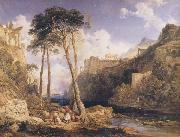 |
James Duffield Harding
|
|
English Painter, ca.1797-1863
English painter, engraver and writer. He received his first lessons in painting from his father, J. Harding (d 1846), who was a pupil of Paul Sandby. By 1807 the family had moved to Greenwich where Harding spent much of his time drawing and painting in Greenwich Park. In 1811 at the age of 14 he exhibited for the first time at the Royal Academy. He had lessons in watercolour painting from Samuel Prout and in 1816 he won the Society of Arts silver medal for landscape painting. |
|
|
James clarke hook,r.a
|
|
1819-1907
English painter. He studied with the portrait painter John Jackson and entered the Royal Academy Schools, London, in 1836, winning medals for drawing and historical painting. His Academy d?but was in 1839 with The Hard Task (untraced). In 1844 Hook was awarded a gold medal in the Houses of Parliament competition. In 1846 he won a Royal Academy travelling scholarship, enabling him to spend two years in Italy, where he was strongly influenced by the colouring of the Venetian painters. On his return his work included a series of subjects from Venetian history, including The Rescue of the Brides of Venice |
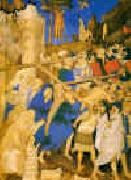 |
Jacquemart de Hesdin
|
|
French Gothic Era Miniaturist, ca.1350-1410
Jacquemart's whole career developed at Bourges (the capital of the Province of Berry) at the court of John, Duke of Berry. He was active in the Duke's service from 1384 until 1414 and made a significant contribution to the Duke's famous illuminated books, in particular the Tr??s Belles Heures du Duc de Berry, the Grandes Heures, the Petites Heures, and a Psalter, often working with the Limbourg brothers and the painter known as the Boucicaut Master.
On 28 November 1384, Jacquemart was paid for the first time by the steward of John, Duke of Berry, to cover expenses he and his wife had incurred in Bourges, and he was also paid for his clothes for the coming winter. After 1384, he was paid a regular salary.
In 1398, while Jacquemart was working for Berry in the castle at Poitiers, he was accused with his assistant Godefroy and with his brother-in-law Jean Petit of the theft of colours and patterns from Jean de Hollande, another painter who worked for Berry. Jacquemart is recorded as staying in Bourges in 1399.
The Tr??s Belles Heures du Duc de Berry (also sometimes called the Brussels Hours, from the city where it has long been kept) is chiefly the work of Jacquemart. The book is described in an inventory of Berry's library dated 1402:
?? Unes tr??s belles heures richement enlumin??es et ystori??es de la main Jacquemart de Odin. ??
The Tr??s Belles Heures disappeared for several hundred years, but the scholarly consensus is that the manuscript in the Biblioth??que Royale at Brussels is the one described in the 1402 inventory.
The Petites Heures is believed to date from before 1388, apart from a miniature of the Duke of Berry himself added later by the Limbourg brothers. Millard Meiss suggests that at least five painters worked on the book's illuminations, Jacquemart and four unidentified artists. One of these four is commonly referred to as the Pseudo-Jacquemart.
Jacquemart's small painting The Carrying of the Cross (vellum mounted on canvas, 38 cm by 28 cm, dated before 1409) is in the Mus??e du Louvre. |
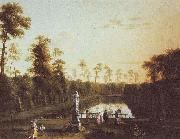 |
Jacob Philipp Hackert
|
|
(September 15, 1737 - April 28, 1807) was a landscape painter from Brandenburg, who did most of his work in Italy.
Hackert was born in 1737 in Prenzlau in the Margraviate of Brandenburg (now in Germany). He trained with his father Philipp (a portraitist and painter of animals) and his uncle, before going to the Akademie der Kenste in Berlin in 1758. Later he traveled to Swedish Pomerania and Stockholm, where he painted murals.
He spent from 1765 to 1768 in Paris, with the Swiss Artist, Balthasar Anton Dunker, where he focused on painting in gouache. He met and was inspired by Claude Joseph Vernet, who was already famous as a painter of landscapes and seascapes, and the German engraver Johann Georg Wille.
In 1768 Hackert left Paris with his brother Georg, and went to Italy, basing himself mainly in Rome and Naples, where he produced many works for Sir William Hamilton. He travelled all over Italy, gaining a reputation as a talented landscape painter.
In 1786 he went to work for Ferdinand I of the Two Sicilies in Naples. He advised on the creation of a painting restoration laboratory at the Museo di Capodimonte, and supervised the transfer of the Farnese collections from Rome to Naples. By this time he had an international reputation, and won commissions from empress Catherine II of Russia, king Louis XVI of France and others. When Goethe visited Naples in 1786, he and Hackert became friends. |
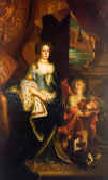 |
Jacob Huysmans
|
|
1633-1696
Flemish
Jacob Huysmans Gallery
Jacob Huysmans (c.1633?C1696), was a Flemish portrait painter. He moved to England during the reign of Charles II where he became one of the fashionable painters of the court. His chief portraits are those of Izaak Walton and Catherine of Braganza, Charles II's wife (both displayed on the National Gallery, London).
He was a pupil of Gilles Backereel and Frans Wouters and came over to England from - presumably - Antwerp. His first works were pastiches of work from Anthony van Dyck. As a Roman Catholic he was favoured by Catharine of Braganza. When Samuel Pepys visited his workshop in Westminster on 26 August 1664, he described him as a 'picture-drawer ... which is said to exceed Lilly (Lely). Huysmans's most important portrait of Catharine of Braganza, Queen Catharine as a Shepherdess (c. 1664; Brit. Royal Col.), was one of the pictures Pepys saw on that occasion. Painting his subjects as sheperdesses with clothing embellished with embroidery and jewellery were typical of his style.
|
 |
Jacob Heinrich Elbfas
|
|
Swedish, born circa 1600-1664,was a portrait painter Elbfas was educated in Strasbourg in a tradition drawing back to Renaissance portraits. He established himself in Sweden from 1622 and from 1628 in Stockholm where he became a guild master. During the period 1634-1640 he worked as a court painter for Queen Maria Eleonora. His was frequently employed by the Swedish nobility and his influence on Swedish art was considerable until a new generation of artists were invited by Queen Christina during the 1640s. |
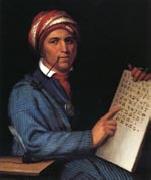 |
Inman Henry
|
|
American portrait, genre, and landscape painter, 1801-1846
The son of an English land agent who had emigrated to America in 1792, he studied under an itinerant drawing-master before moving to New York with his family in 1812. Two years later he obtained an apprenticeship with the city's leading portrait painter, John Wesley Jarvis, drawn to the artist not only for his skill but also for his collection of pictures, which at that time included Adolf Ulric Wertmuller's Danae and the Shower of Gold (1787; Stockholm, Nmus.). Inman worked closely with Jarvis, eventually accompanying him on his travels and serving more as a collaborator than an apprentice. Within this partnership Inman established a speciality in miniature painting. In 1823 he set up his own practice in New York and ceded miniature painting to his student and eventual partner Thomas Seir Cummings (1804-94). |
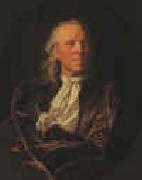 |
Hyacinthe Rigaud
|
|
1659-1743
French
Hyacinthe Rigaud Gallery
He was born Jacint Rigau i Ros [1] -- though in many encyclopaedias is "re-christened" with the name of H??acint Francesc Honrat Mathias Pere Martyr Andreu Joan Rigau -- in Perpignan, which became French (Treaty of the Pyrenees) a short time after his birth (November 7, 1659).
In 1682, he was awarded the Prix de Rome.
He was the most important portrait painter in the reign of King Louis XIV. His instinct for impressive poses and grand presentations precisely suited the tastes of the royal personages, ambassadors, clerics, courtiers, and financiers who sat for him.
Because Rigaud's paintings captured very exact likenesses along with the subject's costumes and background details, his paintings are considered precise records of contemporary fashions. Rigaud was a master of the Baroque style of art. Rigaud's best-known work is his 1701 painting of Louis XIV which today hangs in the Louvre in Paris, as well as the second copy also requested by Louis XIV which is now at Versailles.
In 1709 he was made a noble by his hometown of Perpignan. In 1727 he was made a knight of the Order of Saint Michael.
Hyacinthe Rigaud died in Paris, France on December 27, 1743. |
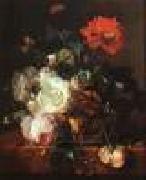 |
HUYSUM, Jan van
|
|
Dutch Painter, 1682-1749
Dutch painter of still life and landscapes. His father was Justus van Huysum (1659?C1716), a successful landscape and genre painter of Amsterdam. Although he painted landscapes in a classical style, Jan is best known for his flower and fruit still lifes in oil and in watercolor. These are distinguished for their brilliant light and shade effects, delicacy of coloring, and exquisite finish. They are to be found in most of the leading European museums |
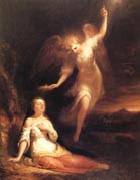 |
Huntington Daniel
|
|
American Hudson River School Painter.
b.1816 d.1906
was born in New York City, New York, the son of Benjamin Huntington, Jr. and Faith Trumbull Huntington; his paternal grandfather was Benjamin Huntington, delegate at the Second Continental Congress and First U.S. Representative from Connecticut. In 1835 he studied with SFB Morse, and produced "A Bar-Room Politician" and "A Toper Asleep." Subsequently he painted some landscapes on the Hudson river, and in 1839 went to Rome. On his return to America he painted portraits and began the illustration of The Pilgrim's Progress, but his eyesight failed, and in 1844 he went back to Rome. Returning to New York around 1846, he devoted his time chiefly to portrait-painting, although he has painted many genre, religious and historical subjects. He was president of the National Academy from 1862 to 1870, and again in 1877-1890. |
 |
Huldrych Zwingli
|
|
1484-1531 fordomde alla kyrkliga bruk som inte hade sin grund i bibeln |
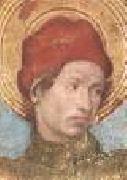 |
HUGUET, Jaume
|
|
Spanish Early Renaissance Painter, ca.1415-1492
Spanish painter. He is thought to have spent time in Saragossa in his youth (c. 1435-45), and he subsequently worked in Tarragona before establishing himself in Barcelona in 1448. He must, however, have had contact with painting from Barcelona before he moved there, because the centre panel of an early retable dedicated to the Virgin (Barcelona, Mus. A. Catalunya) from Vallmoll, near Tarragona, shows his awareness of the style of Bernat Martorell in the profiles of the two foreground angels, and of Llu?s Dalmau's Virgin of the Councillors (Barcelona, Mus. A. Catalunya) in the illusionistic painting of the Virgin's jewel-trimmed garments. In other early works, such as the Annunciation and Crucifixion from a small retable (Vic, Mus. Episc.), |
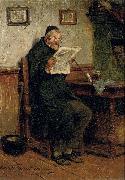 |
Hugo Wilhelm Kauffmann
|
|
(7 August 1844 - 30 December 1915) was a German painter, the son of Hermann Kauffmann.
Kauffmann was born in Hamburg. In 1861 he went to Frankfurt and worked there under Jakob Becker, Edward Jakob von Steinle and Johann Nepomuk Zwerger. From 1863-71 he lived in Kronberg in the Taunus. During this time he spent one winter in Hamburg and a five-month period in Desseldorf too; afterwards he spent 1½ years in Paris, until 1870 when the war drove him out. He lived until 1871 in Munich. He died in Prien at the Chiemsee in 1915.
|
 |
Hugo Vogel
|
|
painted Martin Luther preaching at the Wartburg in 1882 |
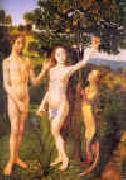 |
Hugo van der Goes
|
|
1440-1482
Flemish
Hugo van der Goes Galleries
Hugo became a member of the painters' guild of Ghent as a master in 1467. In 1468 he was involved in the decoration of the town of Bruges in celebration of the marriage between Charles the Bold and Margaret of York and he provided heraldic decorations for Charles's joyeuse entr??e to Ghent in 1469 and again in 1472. He was elected dean of the Ghent guild in 1473 or 1474.
In 1475, or some years later, Hugo entered Rooklooster, a monastery near Brussels belonging to the Windesheim Congregation, and professed there as a frater conversus. He continued to paint, and remained at Rooklooster until his death in 1482 or 1483. In 1480 he was called to the town of Leuven to evaluate the Justice Scenes left unfinished by the painter Dieric Bouts on his death in 1475. Shortly after this, Hugo, returning with other members of his monastery from a trip to Cologne, fell into a state of suicidal gloom, declaring himself to be damned. After returning to Rooklooster, Hugo recovered from his illness, and died there. His time at Rooklooster is recorded in the chronicle of his fellow monk, Gaspar Ofhuys. A report by a German physician, Hieronymus M??nzer, from 1495, according to which a painter from Ghent was driven to melancholy by the attempt to equal the Ghent Altarpiece, may refer to Hugo.
His most famous surviving work is the Portinari Triptych (Uffizi, Florence), an altarpiece commissioned for the church of San Egidio in the hospital of Santa Maria Nuova in Florence by Tommaso Portinari, the manager of the Bruges branch of the Medici Bank. The triptych arrived in Florence in 1483, apparently some years after its completion by van der Goes. The largest Netherlandish work that could be seen in Florence, it was greatly praised. Giorgio Vasari in his Vite of 1550 referred to it as by "Ugo d'Anversa" ("Hugo of Antwerp"). This the sole documentation for its authorship by Hugo; other works are attributed to him based on stylistic comparison with the altarpiece.
Hugo appears to have left a large number of drawings, and either from these or the paintings themselves followers made large numbers of copies of compositions that have not survived from his own hand. A drawing of Jacob and Rachel preserved at Christ Church, Oxford is thought to be a rare surviving autograph drawing. |
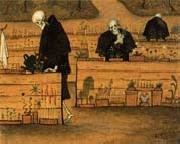 |
Hugo Simberg
|
|
Hamina 1873-1917 Ahtari, Finnish painter and printmaker. He first studied at the Finnish Fine Arts Association in Helsinki. His natural inclination towards mysticism led him to seek the instruction of Akseli Gallen-Kallela, with whom he studied in Ruovesi intermittently between 1895 and 1897. Gallen-Kallela's influence, in particular his Symbolist synthesis of the National Romantic style, is evident in Simberg's early works, such as Frost and Autumn (both 1895; Helsinki, Athenaeum A. Mus.), which are highly personal expressions of the mysticism of nature. |
 |
Hugo Birger
|
|
Swedish, 1854-1887
Swedish painter. He studied at the Konstakademi in Stockholm from 1871 to 1877. In 1877 he went to Paris and then spent the summer of 1878 at Barbizon with Carl Larsson, among others. There he painted several spontaneous plein-air paintings, such as Rue Gabrielle (1879; Goteborg, Kstmus.), in which the grey tones are contrasted realistically with exquisite colours. He also painted scenes of Parisian life, such as The Toilette (1880; two sketches in Stockholm, Nmus.), which aroused the interest of his contemporaries when it was exhibited at the Salon that year. Birger art was always conventional in style, allied to French salon painting. He was a master of technique and a brilliant subject painter, creating such scenes as In the Bower (c. 1880; Stockholm, Nmus.). |
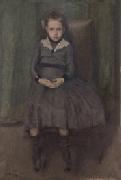 |
Hugh Ramsay
|
|
Australian portrait painter ,
1877 - 1906
was an Australian artist. Ramsay was born in Glasgow, Scotland, son of John Ramsay. He moved with his family to Melbourne in 1878. He was educated at Essendon Grammar School, and joined classes at the National Gallery of Victoria at age 16 under Lindsay Bernard Hall and became one of the most brilliant students ever trained there. He won several first prizes, and at the competition for the travelling scholarship held in 1899 was narrowly beaten by Max Meldrum, another student of unusual ability. Ramsay went to Europe in September 1900 and was fortunate in finding a kindred spirit, George Washington Lambert, on the same vessel. Arriving at Paris he entered Acad??mie Colarossi and was soon recognized as a student of great potential. He sent five pictures to the 1902 exhibition of La Soci??t?? Nationale des Beaux Arts and four of these were accepted and hung together. No greater compliment could have been paid to a young student. Another Australian student whose studio was in the same building, Ambrose McCarthy Patterson (nephew of Nellie Melba, then at the height of her fame). Ramsay was introduced to Melba, who gave him a commission for a portrait and would no doubt have been able to help him in his career. Unfortunately Ramsay became ill in Paris, and it became necessary for him to return to the warmer climate of Australia and the opportunity to paint Melba was missed. Before leaving Europe he had exhibited four pictures at the British Colonial Art Exhibition held in London at the Royal Institute galleries. Returning to Australia, in spite of failing health, Ramsay succeeded in doing some remarkable work including "The Sisters" now in the Sydney gallery, the "Lady with a Fan" (possibly his most famous painting), the portrait of David Scott Mitchell, and his own portrait now in the Melbourne gallery. He gradually became weaker and died on 5 March 1906. |
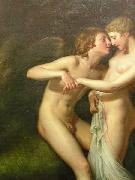 |
Hugh Douglas Hamilton
|
|
(c. 1740 - 10 February 1808) was an Irish portrait-painter.
Biography
Hamilton was born in Crow Street, in Dublin, Ireland, in 1740, the son of a peruke maker. Unfortunately there is very little concrete evidence for his earlylife, apart from his own drawings. He studied art under Robert West at the Dublin Society House - and won some early success with crayon and pastel portraits there. He was very adept at building relationships with patrons from the early days, taking up with the famous La Touche banking family of Dublin, who had close ties with the Bank of Ireland.
Very little is known of Hamilton's career between 1756 and 1764, when he moved to London. Hamilton found great success in London through his pastel oval portraits, portraying royalty, politicians and celebrities of the day through this medium. Hamilton was often overwhelmed with orders, including commissions from the British royal family - such as Queen Charlotte (1764) and others now in the British Royal Collection. He showed with the Society of Artists and the Free Society of Artists from the mid-1760s to the mid-1770s. From the mid-1770s on, Hamilton became very interested in a softer, more textural form of pastel "fresco", in which he blended crayons and chalk to further the pastel's ability to imitate flesh.
In 1779 he travelled to Italy, where he remained for the next twelve years, occasionally visiting Florence but mainly based in Rome, where he knew Antonio Canova. On the advice of artist John Flaxman Hamilton turned to oil painting, and achieved great success with small oval portraits of Irish and British visitors. His portraits of this period include those of Dean Kirwan (displayed at the Royal Dublin Society), George John, 2nd Earl Spencer, Countess Cowper (1787), and the exiled Charles Edward Stuart ( Lord Edward, 1785).
In 1791 Hamilton returned to Dublin, where he died. In 1796 he painted Lord Edward Fitzgerald, the Irish revolutionary.
|
 |
Hubert Vos
|
|
(1855-1935) was a Dutch painter who was born in Maastricht on February 15, 1855. He studied at the Academie Royale des Beaux-Arts in Brussels and with Fernand Cormon (1845-1924) in Paris. He exhibited widely in Paris, Amsterdam, Brussels, Dresden and Munich. From 1885 to 1892, he worked in England, where he exhibited at the Royal Academy between 1888 and 1891. He was a member of the Royal Society of British Artists.
In 1898, he visited Hawaii, where he painted the local people. In that same year, Vos traveled to Korea, where he completed at least three paintings in duplicate. In each case, he left one copy in Korea and kept one copy. The paintings are a life-sized portrait of Emperor Gojong, a portrait of Min Sang-ho (1870-1933) and a landscape of Seoul. The copies left in Korea hung in the Deoksugung Palace until all except the landscape of Seoul, were destroyed by fire in 1904. In 1905, on his second and last trip around the world. |
 |
Hubert Robert
|
|
(22 May 1733 - 15 April 1808), French artist, was born in Paris.
His father, Nicolas Robert, was in the service of François-Joseph de Choiseul, marquis de Stainville a leading diplomat from Lorraine. Young Robert finished his studies with the Jesuits at the College de Navarre in 1751 and entered the atelier of the sculptor Michel-Ange Slodtz who taught him design and perspective but encouraged him to turn to painting. In 1754 he left for Rome in the train of Étienne-François de Choiseul, son of his father's employer, who had been named French ambassador and would become a Secretary of State for Foreign Affairs to Louis XV in 1758.
|
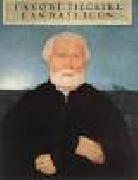 |
HUBER, Wolf
|
|
German Northern Renaissance Painter, ca.1490-1553 |
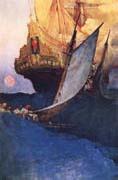 |
Howard Pyle
|
|
One of the great illustrators of the 19th century.
American
1853-1911
was an American illustrator and writer, primarily of books for young audiences. A native of Wilmington, Delaware, he spent the last year of his life in Florence, Italy. In 1894 he began teaching illustration at the Drexel Institute of Art, Science and Industry (now Drexel University), and after 1900 he founded his own school of art and illustration called the Howard Pyle School of Illustration Art. The term the Brandywine School was later applied to the illustration artists and Wyeth family artists of the Brandywine region by Pitz (later called the Brandywine School). Some of his more famous students were Olive Rush, N. C. Wyeth, Frank Schoonover, Elenore Abbott, and Jessie Willcox Smith. His 1883 classic The Merry Adventures of Robin Hood remains in print to this day, and his other books, frequently with medieval European settings, include a four-volume set on King Arthur that cemented his reputation. He wrote an original work, Otto of the Silver Hand, in 1888. He also illustrated historical and adventure stories for periodicals such as Harper's Weekly and St. Nicholas Magazine. |
 |
Horst Devens
|
|
painted Freiin Emma von Langenmantel-Rosenberg in 1873 |
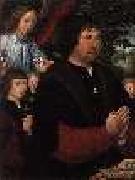 |
HORENBOUT, Gerard
|
|
Flemish Northern Renaissance Painter and Manuscript Illuminator, ca.1465-1541
Painter, designer, scribe and cartographer. He may have been the pupil of Li?vin de Stoevere ( fl 1463), the only painter of the five artists who guaranteed his admission fee into the guild of painters and illuminators in Ghent in 1487. Horenbout became a versatile and productive artist, painting altarpieces, portraits and illuminated manuscripts and designing tapestries and stained-glass windows. He also collaborated with the nuns of the convent of Galilee near Ghent in making a model garden with flowers made of cloth that he delivered to Margaret of Austria, Regent of the Netherlands, at her court in Mechelen. He seems to have achieved a degree of wealth commensurate with his output: in 1503 he acquired a house |
 |
Horatio Walker
|
|
(May 12, 1858 - September 27, 1938) was a respected and commercially successful Canadian painter. He worked in oils and watercolors, often depicting scenes of rural life in Canada. He was highly influenced by the French Barbizon school of painting.
Horatio Walker was born in 1858 to parents Thomas and Jeanne Maurice Walker. Thomas Walker emigrated in 1856 from Yorkshire, England, to Listowel, Ontario, with his wife of French and English heritage. Having some wealth, Thomas purchased land for lumber in Midwestern Ontario and Horatio was raised in relative comfort. His interest in art may originate from his father who crafted small figures as a hobby, and both his father and the local school teacher encouraged drawing as a pastime.
In 1870, on Walkeres 12th birthday, his father brought him to Quebec City, Quebec, for the first time. His father made occasional business trips to the city as part of his timber business. During this sojourn, they visited the Île d'Orleans, in search of pine timber. Walker made subsequent visits to Quebec City during the following years. His formal schooling ended at the Listowel Public School in 1872; he never went on to pursue formal academic training in art. At the age of 15, Walker moved to Toronto, Ontario to apprentice with the photographic firm Notman and Fraser. It was a fortunate opportunity, as several successful artists worked also there; Walker learned watercolour from Robert Gagnon, miniature portrait painting from John Fraser, and painting from Lucius OeBrien and Henri Perre. |
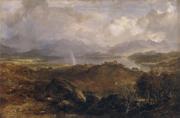 |
Horatio Mcculloch
|
|
Scottish Landscape painter ,1805-1867
Scottish painter. He was trained in the studio of the Glasgow landscape painter John Knox (1778-1845) and at first earned his living as a decorative painter. By the early 1830s McCulloch's exhibits with the Glasgow Dilettanti Society and with the Royal Scottish Academy had begun to attract buyers, notably the newly instituted Association for the Promotion of the Fine Arts in Scotland. Commissions from book and print publishers allowed him to concentrate on easel painting. On his election as full Academician of the Scottish Academy in 1838, McCulloch settled in Edinburgh and soon became a prominent figure in the artistic life of the capital and a prolific contributor to the Royal Scottish Academy exhibitions. At the same time contact with Glasgow was maintained: McCulloch's favourite sketching grounds were in the west, he exhibited regularly in the city and his most loyal patrons were wealthy Glasgow industrialists such as David Hutcheson (1799-1881), the steamship owner. He seldom exhibited outside Scotland and only once at the Royal Academy, London (1843), but he kept in touch with London artist-friends, John Phillip, David Roberts and John Wilson (1774-1855), through correspondence and visits. His own art collection was evidence of his admiration for 17th-century Dutch painters, for J. M. W. Turner and Richard Wilson. |
 |
Horace Vernet
|
|
French Academic Painter, 1789-1863, Painter, son of Carle Vernet. He was born in his father's lodgings at the Palais du Louvre, where his grandfather Joseph Vernet also lived; his maternal grandfather was Jean-Michel Moreau. To these antecedents and influences are ascribed the supreme ease of his public career, his almost incredible facility and his fecundity. His early training in his father's studio was supplemented by formal academic training with Franeois-Andre Vincent until 1810, when he competed unsuccessfully for the Prix de Rome. He first exhibited at the Salon in 1812. In 1814 Vernet received the Legion d'honneur for the part he played in the defence of Paris, which he commemorated in the Clichy Gate: The Defence of Paris, 30 March 1814 |
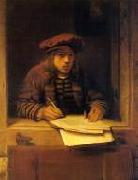 |
HOOGSTRATEN, Samuel van
|
|
Dutch Baroque Era Painter, 1627-1678
Dutch painter, draughtsman, engraver and writer. His multi-faceted art and career testify amply to the unflagging ambition attributed to him as early as 1718 by his pupil and first biographer, Arnold Houbraken. During his lifetime van Hoogstraten was recognized as a painter, poet, man of letters, sometime courtier and prominent citizen of his native city of Dordrecht, where he served for several years as an official of the Mint of Holland. Today he is remembered not only as a pupil and early critic of Rembrandt, but also as a versatile artist in his own right. His diverse oeuvre consists of paintings, drawings and prints whose subjects range from conventional portraits, histories and genre pictures to illusionistic experiments with trompe-l'oeil still-lifes, architectural perspectives and perspective boxes. |
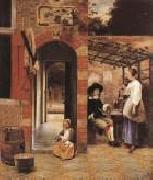 |
HOOCH, Pieter de
|
|
Dutch Baroque Era Painter, 1629-1684
Dutch painter. He was one of the most accomplished 17th-century Dutch genre painters, excelling in the depiction of highly ordered interiors with domestic themes and merry companies and pioneering the depiction of genre scenes set in a sunlit courtyard. The hallmarks of his art are an unequalled responsiveness to subtle effects of daylight, and views to adjoining spaces, either through a doorway or a window, |
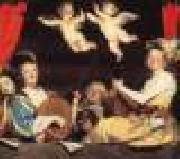 |
HONTHORST, Gerrit van
|
|
Dutch Baroque Era Painter, ca.1590-1656
Dutch portrait, genre, and allegorical painter. In Italy (c.1610?C1620) he gained a sound understanding of the works of Caravaggio, which greatly affected his style. He was a master at painting candlelit genre pieces and biblical scenes. Upon his return to Holland, he introduced the Italian manner of illusionistic decoration into Dutch interiors, as in his decorative scheme for the palace of Honselaarsdijk. In 1628, Charles I invited him to England, where he decorated Whitehall and painted portraits of the king and nobility. Several of these are now in the National Gallery, London. He also worked for the court of Denmark, and from 1637 to 1652 at The Hague. Together with Terbrugghen and Baburen he led the influential Utrecht school of painting that introduced Caravaggesque dramatic realism into Dutch art. |
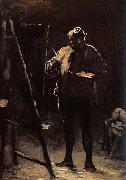 |
Honore Daumier
|
|
French Realist Illustrator, 1808-1879
was a French printmaker, caricaturist, painter, and sculptor, whose many works offer commentary on social and political life in France in the 19th century. A prolific draftsman who produced over 4000 lithographs, he was perhaps best known for his caricatures of political figures and satires on the behavior of his countrymen, although posthumously the value of his painting has also been recognized. Daumier was born in Marseille to Jean-Baptiste Louis Daumier and C??cile Catherine Philippe. His father Jean-Baptiste was a glazier whose literary aspirations led him to move to Paris in 1814, seeking to be published as a poet. In 1816 the young Daumier and his mother followed Jean-Baptiste to Paris. Daumier showed in his youth an irresistible inclination towards the artistic profession, which his father vainly tried to check by placing him first with a huissier, for whom he was employed as an errand boy, and later, with a bookseller. In 1822 he became prot??g?? to Alexandre Lenoir, a friend of Daumier's father who was an artist and archaeologist. The following year Daumier entered the Acad??mie Suisse. He also worked for a lithographer and publisher named Belliard, and made his first attempts at lithography. Having mastered the techniques of lithography, Daumier began his artistic career by producing plates for music publishers, and illustrations for advertisements. |
 |
Honore Daumier
|
|
1808-1879
French
Honore Daumier Locations
In some 40 years of political and social commentary Honore Daumier created an enormously rich and varied record of Parisian middle-class life in the form of nearly 4,000 lithographs, about 1,000 wood engravings, and several hundred drawings and paintings. In them the comic spirit of Moli??re comes to life once again. After having been the scourge of Louis Philippe and the July Monarchy (1830-1848), Daumier continued as a satirist of Louis Napoleon and the Second Empire (1851-1870). Poor himself, the artist sympathized with the struggling bourgeois and proletarian citizens of Paris. As a man of the left, he battled for the establishment of a republic, which finally came in 1870. Liberals have always applauded Daumier; some conservatives, however, have been inclined to consider him woolly-minded.
Honore Daumier, born on Feb. 26, 1808, in Marseilles, was the son of a glazier. When Honore was 6, the family moved to Paris, where the elder Daumier hoped to win success as a poet. Honore grew up in a home in which humanistic concerns had some importance. A born draftsman and designer who was largely self-taught, he received some formal instruction from Alexandre Lenoir, one of Jacques Louis David students. An obscure artist named Ramelet taught Daumier the elements of the new, inexpensive, and popular technique of lithography. Daumier style is so much his own that it is not easy to disentangle influences from other artists. Rembrandt and Francisco Goya are usually mentioned, along with Peter Paul Rubens, the Venetian school, and photography. |
|

